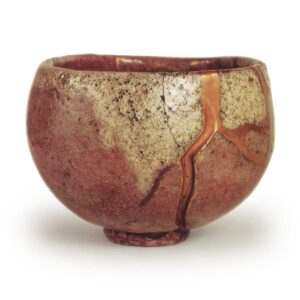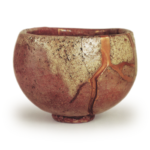

Important Cultural Property
Collection: Hatakeyama Memorial Museum
Height: 9.2-9.5cm
Bowl diameter: 11.0-11.6cm
Outer diameter of stand: 4.1 – 4.2 cm
Height: 1.0cm
The inscription “Snow peak” was probably given to this vase because of the magnificent white streaks from the mouth rim to the body, which resembles the white snow falling on the mountain peaks.
It is one of the five or seven types of Koetsu teacups, and along with Bishamondo, it has been known since ancient times as one of the twin perfect examples of Koetsu red teacups. The unique round shape of the body is so full that it is almost torn off, and the gold repairing of the large fire cracks, which corresponds with the vigorous self-flagellation, further strengthens the violent impression of this teacup.
The body is rather thick, and the edge of the mouth is held back, and the body is strongly bent from the body to the hem. The mouth spatula, which is Koetsu’s specialty, can be seen in some parts, and the fire crack, which is a characteristic of this tea bowl, is especially intense in this tea bowl, and the effect is further enhanced by the gold repairing. Koetsu seems to have fired the bowl with high heat, and the fire cracks are also considered to be due to that, which is also a characteristic and a major highlight of this bowl.
The glaze, which is also a beadlo glaze unique to Koetsu, is beautiful and lustrous. The white from the mouth rim to the body is beautiful and attractive.
The white patches from the mouth rim to the body are probably the result of double glazing, and the white of the translucent white is particularly brilliant, contrasting strongly with the red of the base. The front of the bowl is wide and the center of the tea bowl is slightly elevated, but it is also covered in white. The height has a five-tone finish, and the sharply gouged interior fully reveals the characteristics of Koetsu’s use of spatula, which is further enhanced by the fire cracks on the sides.
In other words, Koetsu’s spirited style, coupled with the high-fired firing, has unintentionally produced the Seiho Tea Bowl here. At first glance, it looks as if it could be contained in a round shape in one’s hand, but at the same time, one can feel the intense power of the bowl spreading out in one’s hand.
This is the same type of Koetsu kyobako as Fujisan, and was probably fired at Takagamine in the last years of his life.
The accessories are as follows,
Inner box, painted in tame lacquer, gold-painted letters on the front of the lid, Koetsu “Seppo Daikyoan
It was originally handed down to the Mii family and later to the Sakai family, lords of Himeji Castle, but in recent years it came into the possession of the sukiya Hatakeyama Issei, and is now in the collection of the Hatakeyama Memorial Museum of Fine Arts.








